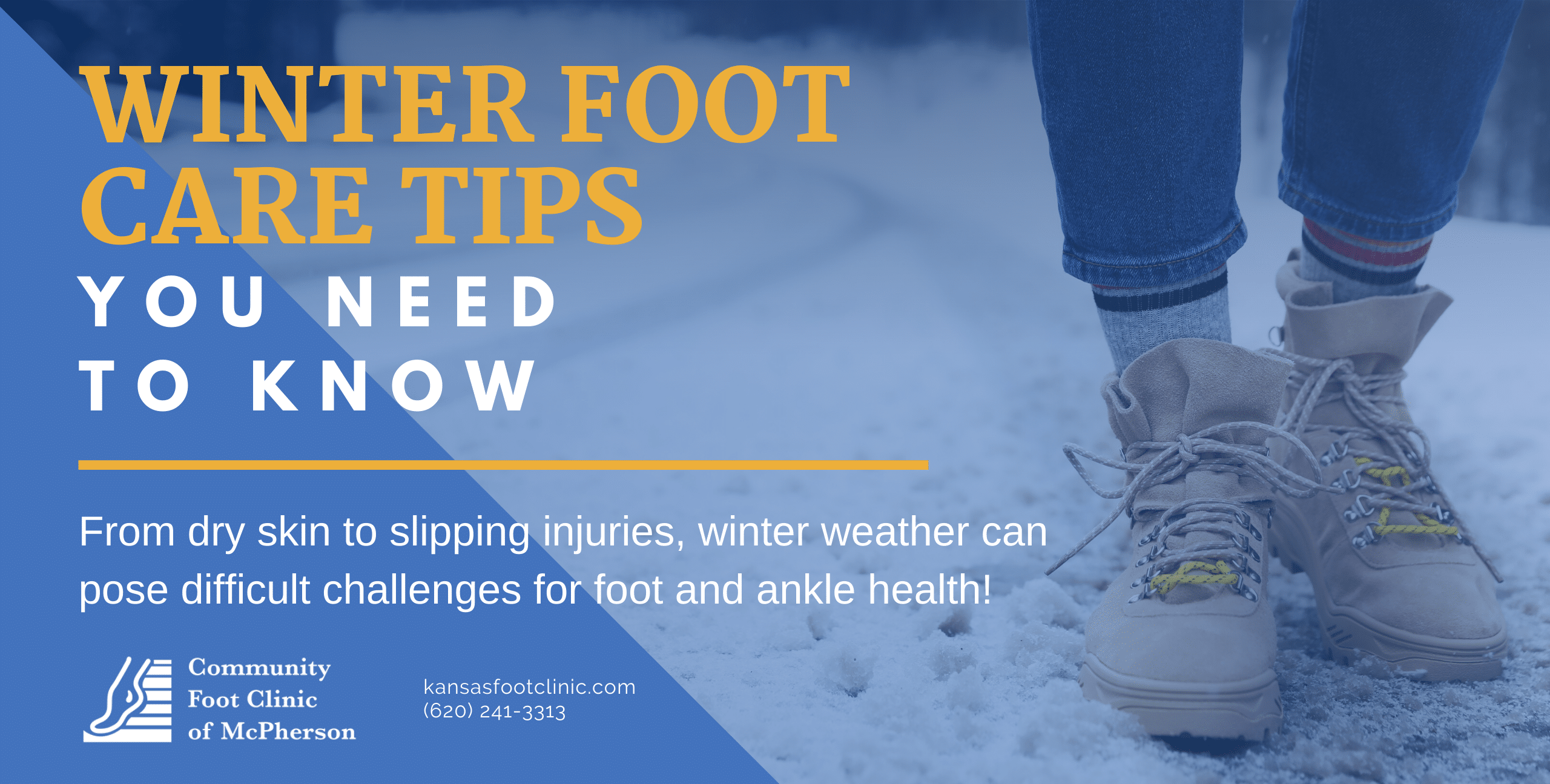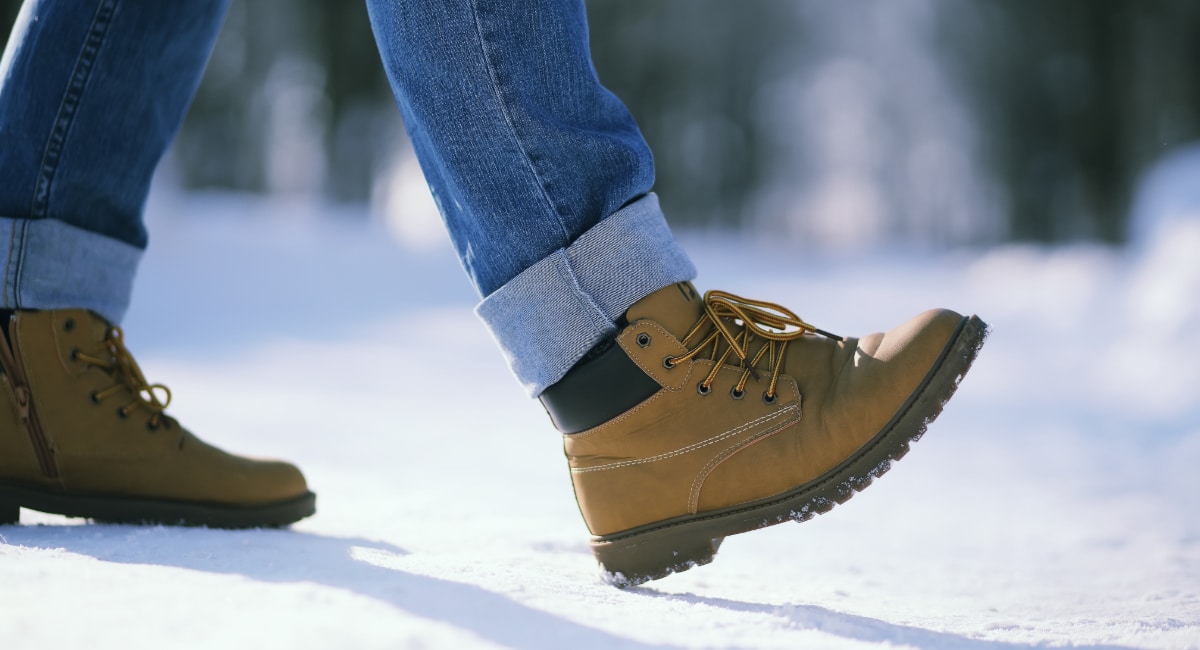Winter Foot Care Tips You Need to Know
Here in the Great Plains, cold, dry, and highly variable winters are the norm. While no one would mistake McPherson, KS for, say, Duluth, MN, we do get our fair share of frosty, snowy mornings—with a handful of truly brutal low temperatures every now and again.
In short: certainly not the worst winters in America, but definitely still winter. And for that reason, winter foot care has to stay on your radar. Chilly weather (and the way we handle it, both indoors and out) can do a surprising amount of damage, particularly to the health and appearance of your skin and nails.
To learn why this is the case—and what you can do about it—please read on!
The Hazards of Winter for Your Feet
Let’s examine and assess some of the biggest risks:
- Cold temperatures. The most obvious risk, of course, is just the fact that it’s so cold outside. Unprotected exposure to the elements can lead to frostbite in a surprisingly short amount of time, especially for vulnerable toes. It’s also dangerous for those with neuropathy or diabetes.
- Dry environments. Winters here are already relatively dry compared to the rest of the year. Then, indoor heating systems and furnaces remove even more moisture from the air. The result, for many, is scaly and cracked skin desperate for moisture.
- Swampy footwear. Winter and damp feet go together distressingly often, whether it’s because your feet spend all day in waterproof boots that trap your sweat, or you’re walking through snow and sleet in mesh-top tennis shoes. Unfortunately, this can often lead to issues such as athlete’s foot, fungal toenails, foul odor, blisters, and more.
- It doesn’t take a whole lot of precipitation or temperatures all that cold to produce very dangerous and slippery conditions. For that reason, we see a lot of sprained ankles and other injuries right after severe winter weather.
Tips to Keep Your Feet Safe This Winter
To make this simpler and easier to digest, we’ll break it down by category.
Footwear Tips
Make sure your shoes or boots are:
- Warm enough. Never spend long periods of time outdoors in shoes or boots that aren’t suitable for the intensity of the weather. A reliable pair of warm, waterproof boots is an absolute must.
- Activity-appropriate. That said, once you’re inside, you’ll want to change into a more comfortable, breathable pair of shoes. And of course, if you’re going to be heading out on the ice or playing any winter sports, you need your shoes to give you the traction and grip you need to keep your balance and minimize your injury risk.
- Changed when damp. You don’t want to spend a minute longer than you have to in damp shoes or socks. Always change them when they get wet. We’d also recommend you rotate shoes on a daily basis and use antiperspirant / antifungal powders or sprays so that they dry out and don’t allow fungi to gain a foothold (pun intended).
- Fitted properly and comfortably. All forms of footwear should offer good arch support, cushioning, and plenty of wiggle room for the toes. That’s as true for winter boots as it is for summer running shoes.
Hygiene Tips
During winter conditions, you’ll need to be especially vigilant about hygiene and skin care.
- Wash feet daily. It keeps the fungal and odor-causing infections away. Avoid harsh soaps. Make sure you hit the areas between the toes!
- Keep showers short and not too hot. Scalding showers might feel great in winter, but they actually damage your skin and dry it out. Fifteen minutes of bliss isn’t worth it.
- Moisturize regularly. Right after your shower, when your skin is still a little bit damp, apply the moisturizing cream or lotion to lock in the moisture and reduce / prevent cracks and dry skin.
- Keep toenails trimmed. Since we’re guessing you aren’t wearing open toed shoes too often in winter, it’s especially important to keep your toenails at an appropriate length. This reduces the risk of toenail trauma (such as ingrown toenails) throughout the season.
- Don’t use nail polish. Winter isn’t exactly prime nail painting season anyway, so you might as well let it rest until summer. Wearing nail polish for more than a week at a time can actually keep your nails from breathing properly and create a breeding ground for fungi. If your feet are typically trapped in stuffy winter boots, this effect is magnified further.
Your No. 1 Central Kansas Destination for Foot Care Year Round
You can take it from us: there’s no “off season” for foot and ankle problems. Every type of weather and climate poses its own risks and challenges.
The most important thing is that you deal with problems early, before they have a chance to fester. Toenails looking slightly yellow? Dry skin starting to crack? If you want to avoid a bad infection or more difficult-to-treat pain in the future, take steps to deal with it now!
We are here for you all winter long, so if you do develop any concerns, be sure to call the Community Foot Clinic of McPherson for prompt attention and care. You can reach us online, or dial (620) 241-3313 today.
McPherson Office
316 W. 4th Street
McPherson, KS 67460
P: (620) 241-3313
F: (620) 241-6967
© Community Foot Clinic of McPherson. All Rights Reserved.
Privacy Policy | Terms & Conditions
Web Design by CP Solutions
Marketed by VMD Services


